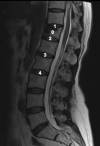Effect of Percutaneous Kyphoplasty on the progression of intervertebral disc degeneration: a retrospective cohort study
- PMID: 36879260
- PMCID: PMC9990346
- DOI: 10.1186/s13018-023-03627-6
Effect of Percutaneous Kyphoplasty on the progression of intervertebral disc degeneration: a retrospective cohort study
Abstract
Background: The effect of percutaneous kyphoplasty (PKP) or rather polymethylmethacrylate (PMMA) on adjacent intervertebral discs is still controversial. The evidence from experimental study to clinical study presents bipolar conclusions. In this study, we investigated the effect of PKP on adjacent intervertebral disc degeneration (IDD).
Methods: The experimental group included adjacent intervertebral discs of vertebrae treated with the PKP procedure, and the control group included adjacent intervertebral discs of non-traumatized vertebrae. All measurements were taken by magnetic resonance imaging or X-ray. The intervertebral disc height, the modified Pfirrmann grading system (MPGS), and its differences with Klezl Z and Patel S (ZK and SP) classifications were compared.
Results: A total of 264 intervertebral discs from 66 individuals were selected for the study. The comparison of intervertebral disc height between the two groups pre and post-operatively resulted in a p-value of > 0.05. No significant change was observed in the adjacent discs in the control groups post-operatively. Post-operatively, the mean Ridit increased significantly from 0.413 to 0.587 in the upper disc and from 0.404 to 0.595 in the lower disc in the experimental group. The comparison of MPGS differences showed that the predominant value was 0 in the Low-grade leaks group and 1 in the Medium and high-grade leaks group.
Conclusions: The PKP procedure can accelerate adjacent IDD, but it does not cause disc height changes in the early stage. The quantity of cement leaking into the disc space positively correlated with the rate of disc degeneration progression.
Keywords: Cement leak; Intervertebral disc degeneration; Percutaneous Kyphoplasty; Polymethylmethacrylate.
© 2023. The Author(s).
Conflict of interest statement
None.
Figures





Similar articles
-
Impact of the quantity of intradiscal cement leak on the progression of intervertebral disc degeneration.Ann R Coll Surg Engl. 2017 Sep;99(7):529-533. doi: 10.1308/rcsann.2017.0083. Ann R Coll Surg Engl. 2017. PMID: 28853606 Free PMC article.
-
Quantitative T2 Mapping Shows Increased Degeneration in Adjacent Intervertebral Discs Following Kyphoplasty.Cartilage. 2020 Apr;11(2):152-159. doi: 10.1177/1947603518758434. Epub 2018 Mar 19. Cartilage. 2020. PMID: 29553284 Free PMC article.
-
Analysis of intervertebral discs adjacent to thoracolumbar A3 fractures treated by percutaneous instrumentation and kyphoplasty.Orthop Traumatol Surg Res. 2020 Oct;106(6):1221-1226. doi: 10.1016/j.otsr.2020.05.006. Epub 2020 Sep 2. Orthop Traumatol Surg Res. 2020. PMID: 32888918 Review.
-
Does Calcium Phosphate Cement Kyphoplasty Cause Intervertebral Disk Degeneration in Adolescents?Cartilage. 2022 Dec;13(4):77-86. doi: 10.1177/19476035221126354. Epub 2022 Oct 18. Cartilage. 2022. PMID: 36254621 Free PMC article.
-
Association between non-traumatic vertebral fractures and adjacent discs degeneration: a cross-sectional study and literature review.BMC Musculoskelet Disord. 2020 Nov 27;21(1):781. doi: 10.1186/s12891-020-03814-0. BMC Musculoskelet Disord. 2020. PMID: 33246433 Free PMC article. Review.
Cited by
-
Analysis of Risk Factors Causing Adjacent Disc Degeneration After Percutaneous Kyphoplasty for Osteoporotic Vertebral Compression Fractures.J Pain Res. 2024 Nov 25;17:3985-3995. doi: 10.2147/JPR.S486668. eCollection 2024. J Pain Res. 2024. PMID: 39619215 Free PMC article.
References
-
- Wright NC, Looker AC, Saag KG, Curtis JR, Delzell ES, Randall S, et al. The recent prevalence of osteoporosis and low bone mass in the United States based on bone mineral density at the femoral neck or lumbar spine. J Bone Miner Res. 2014;29(11):2520–2526. doi: 10.1002/jbmr.2269. - DOI - PMC - PubMed
MeSH terms
LinkOut - more resources
Full Text Sources

